Transducers
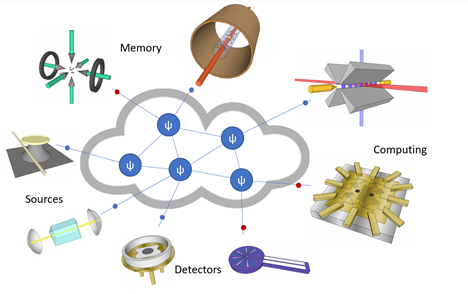
Future distributed quantum computing networks will likely use different technologies and materials to implement particular processes such as the quantum transmission, storage, and computation. The ability to interconvert quantum information between different types of physical qubits – some operating at microwave frequencies, others at optical frequencies – is crucial to enable the use of multiple quantum technologies with different strengths in a single combined quantum communications system or network.
Transduction is an efficient conversion of quantum information from one material system to another without the loss of quantum coherence. In some cases, when a quantum system is capable of generating photons, a transducer converts the available photon to a telecom band and back. In other cases, a conversion is required between a photonic mode and a non-photonic excitation, such as a vibrational degree of freedom.
Quantum transduction between different frequencies in optical and mid-IR wavelength ranges can be achieved using nonlinear frequency conversion. We are currently working on direct quantum memory/computing to telecom (and vice versa) frequency conversion schemes. The main research objective is to reduce background noise and insertion loss of such transducers. Transduction between very distant electromagnetic frequencies, for instance from telecom to microwave domains, is still a challenge. NIST is actively pursuing experimental, theoretical, and design work towards practical transducers. In addition, we are developing metrology tools for characterizing the performance of frequency conversion in quantum networks.
Nearly noiseless visible/Near Infrared (NIR) optical transducers
We study second-order nonlinear devices for transducing photons in the visible and near-IR wavelength ranges. We study the mechanism of noise generation in nonlinear materials and design noise management solutions. We have demonstrated low-noise transduction, with <104 photons/second background noise between the telecom band (1554 nm) and NIR (837 nm). We have shown that the noise figure can in principle be lowered to under ~100 photons per hour. However, the proof of principle experiment connects NIR with visible photons, so it is not telecom compatible. In our efforts, we also research advanced uses of frequency transduction, e.g, for switching and shaping photons.
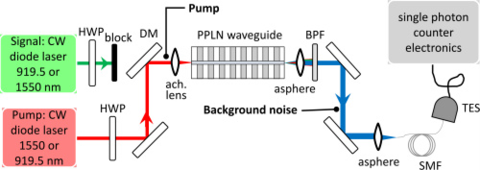

Integrated approaches to transducers are also being developed, for example, in silicon photonic platforms in which third-order nonlinear processes are being harnessed. In these systems, wavelength-scale light confinement enables nonlinear processes to be controlled by geometry, and flexible configuration of different input and output wavelengths can be realized. While additional work is needed to fully characterize noise generation processes in these new quantum frequency conversion platforms, proof-of-principle demonstrations of frequency conversion of single photon Fock states have been conducted.&
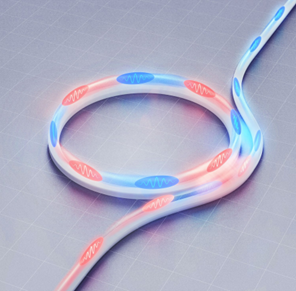
PI contacts: Sergey Polyakov, Paulina Kuo, Thomas Gerrits, Oliver Slattery, Lijun Ma, Xiao Tang, Kartik Srinivasan
Notable Publications:
I.A. Burenkov and S.V. Polyakov, Quantum Frequency Bridge: High-Accuracy Characterization of a Nearly-Noiseless Parametric Frequency Converter, Optics Express, 25, 907-917 (2017) https://doi.org/10.1364/OE.25.000907
P.S. Kuo, J.S. Pelc, O. Slattery, Y. Kim, M.M. Fejer, and X. Tang, Reducing noise in single-photon-level frequency conversion, Optics Letters, 38, 1310-1312 (2013) https://doi.org/10.1364/OL.38.001310
P. Kuo, J. Pelc, C. Langrock, and M. Fejer, Using Temperature to Reduce Noise in Quantum Frequency Conversion, CLEO: Science and Innovations, San Jose, CA, (2018) https://doi.org/10.1364/CLEO_SI.2018.SM2D.5
P. Kuo, J. Pelc, O. Slattery, L. Ma, M. Fejer, and X. Tang, Dual-channel, single-photon upconversion detector at 1300 nm, Nonlinear Photonics 2012, Colorado Springs, CO (2012) https://doi.org/10.1364/NP.2012.NM3C.6
L. Ma, O. Slattery, and X. Tang, Single photon frequency up-conversion and its applications, Physics Reports, 521, 69-94 (2012) https://doi.org/10.1016/j.physrep.2012.07.006
Q. Li, M. Davanco, and K. Srinivasan, Efficient and low-noise single-photon-level frequency conversion interfaces using silicon nanophotonics, Nature Photonics, 10, 406–414 (2016) https://doi.org/10.1038/nphoton.2016.64
A. Singh, Q. Li, S. Liu, Y. Yu, X. Lu, C. Schneider, S. Hofling, J. Lawall, V. Verma, R. Mirin, S. Nam, J. Liu, and K. Srinivasan, Quantum Frequency Conversion of a Quantum Dot Single-Photon Source on a Nanophotonic Chip, Optica, 6, 563-569 (2019) https://doi.org/10.1364/OPTICA.6.000563
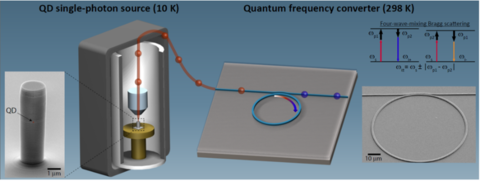

Technology Readiness Level: 6 - TRL1 depending on the sub-project: a few prototypes were demonstrated, advanced low-noise devices exist as a concept.
Optical-to-microwave transducers
Networking of superconducting quantum computers will require transduction of quantum information between the microwave frequencies at which the machines operate and the optical frequencies at which low loss, quantum-preserving transmission can occur (e.g. in standard optical fibers). Right now, no such technology exists at the required fidelity. NIST researchers together with colleagues at the University of Colorado are addressing this problem by developing vibrating membrane convertors (VMC). Inside the VMC is a silicon nitride membrane that can “talk” to both microwave and optical light. Infrared laser light passes through the membrane near, but not touching, a miniature electronic circuit. Microwave signals in the circuit cause the membrane to vibrate, which alters the phase or amplitude of the laser light. Conversely, changes in the phase or amplitude of the laser light cause the membrane to vibrate, producing an electrical signal that encodes the information in a microwave signal. Another approach, also pursued at NIST, is to combine solid-state deterministic quantum photon emitters (self-assembled quantum dots) with quantum mechanical oscillators based on surface acoustic wave cavities. A third NIST approach is to integrate piezoelectric (microwave->acoustic wave) and optomechanical (acoustic wave->optical wave) into a common transducer platform.
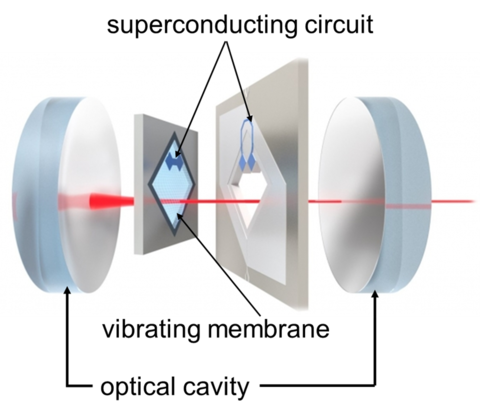
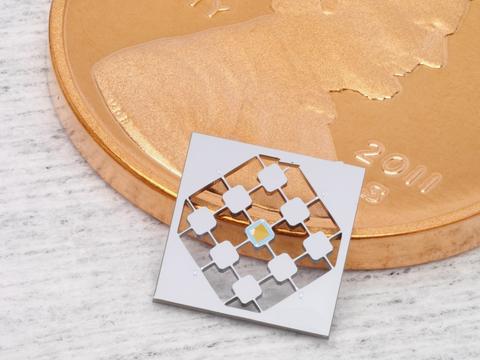
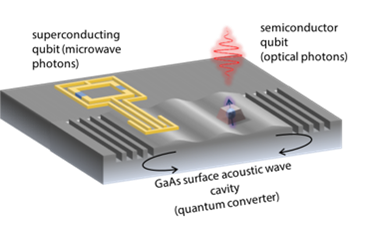
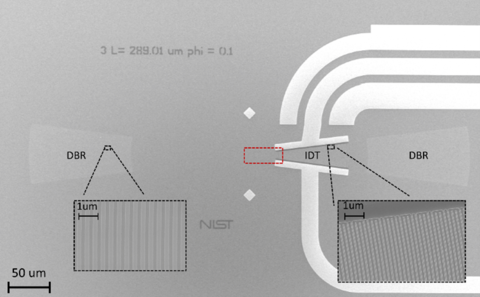
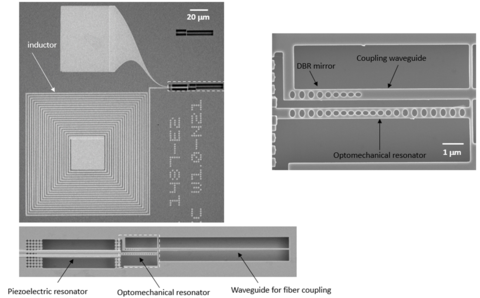
PI contacts: Kevin Silverman and Richard Mirin (quantum dot-based transducer), Konrad Lehnert (vibrating membrane convertor-based transducer), and Kartik Srinivasan (piezo-optomechanical transducer)
Notable Publications:
P. Imany, Z. Wang, R. A. DeCrescent, R. C. Boutelle, C. A. McDonald, T. Autry, S. Berweger, P. Kabos, S.-W. Nam, R. P. Mirin, and K. L. Silverman, Quantum phase modulation with acoustic cavities and quantum dots, Optica, 9, 501 (2022) https://doi.org/10.1364/OPTICA.451418
R.W. Andrews, R.W. Peterson, T.P. Purdy, K. Cicak, R.W. Simmonds, C.A. Regal, and K.W. Lehnert, Bidirectional and Efficient Conversion Between Microwave and Optical Light, Nature Physics, 10, 321-326 (2014) https://doi.org/10.1038/nphys2911
A.P. Higginbotham, P.S. Burns, M.D. Urmey, R.W. Peterson, N.S. Kampel, B.M. Brubaker, G. Smith, K.W. Lehnert, and C.A. Regal, Harnessing Electro-Optic Correlations in an Efficient Mechanical Converter, Nature Physics, 14, 1038-1042 (2018) https://doi.org/10.1038/s41567-018-0210-0
K.C. Balram, M. Davanço, J.D. Song, and K. Srinivasan, Coherent coupling between radiofrequency waves, optical, and acoustic waves in piezo-optomechanical circuits, Nature Photonics, 10, 346-352 (2016) https://doi.org/10.1038/nphoton.2016.46
T.M. Autry, S. Berweger, L. Sletten, R.P. Mirin, P. Kabos, K. Lehnert, and K. Silverman, Surface Acoustic Wave Cavities and InAs Quantum Dots for Quantum Transduction, CLEO: Fundamental Science, FTh4D.6 (2020) https://doi.org/10.1364/CLEO_QELS.2020.FTh4D.6
G.A. Moody, C.A. McDonald, A.D. Feldman, T.E. Harvey, R.P. Mirin, K.L. Silverman (2015), Electronic Enhancement of the Exciton Coherence Time in Charged Quantum Dots, Physical Review Letters, 116, 037402 (2016) https://doi.org/10.1103/PhysRevLett.116.037402
Technology Readiness Level: 3 - Proof-of-Concept
Contacts
-
(301) 975-5887
-
(301) 975-4281
-
(240) 688-8979

